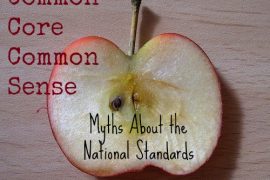In recent months, there’s been a tremendous amount of buzz regarding an educational change called Common Core. And a ton of that buzz perpetuates down-right false information. There’s so much to say about this that I’ve developed a five-part series debunking these myths — or outright lies, if you’re being cynical. This is the first in that series, which will continue on Wednesdays throughout August and into September. Of course, I’ll be writing from a math perspective. Photo Credit: Watt_Dabney via Compfight cc
Myth #1: Common Core is a Curriculum
This is perhaps the most pervasive misunderstanding. In fact, the Common Core Standards are simply that: standards. In education-speak, this means they are statements of what students should know, upon completing a course or grade. Common Core does something a bit more than other sets of standards, giving a clear expectation of the depth of this understanding. Compare these fifth-grade math standards, one from Virginia’s Standards of Learning (SOL) and it’s corresponding objective from Common Core:
SOL: The student will describe the relationship found in a number pattern and express the relationship.
Common Core: Generate two numerical patterns using two given rules. Identify apparent relationships between corresponding terms. Form ordered pairs consisting of corresponding terms from the two patterns, and graph the ordered pairs on a coordinate plane. For example, given the rule “Add 3” and the starting number 0, and given the rule “Add 6” and the starting number 0, generate terms in the resulting sequences, and observe that the terms in one sequence are twice the corresponding terms in the other sequence. Explain informally why this is so.
The Common Core Standard isn’t just longer — it expresses much more depth. Students begin to pay attention to the relationships between numerical expressions, algebraic expressions and graphing. The goal is for students to know that these number patterns can be shown in a variety of different ways. And that’s a pretty big deal when students get into more complex algebra.
But here’s the thing: How students are taught is left completely to school districts and/or states. Some select ready-made curriculum, like Everyday Mathematics. Others opt to develop their own curriculum, which is exactly what my daughter’s middle school did.
Certainly, curriculum development companies have leapt on the opportunity to create new lessons, textbooks, activities and online components that correspond with Common Core. That’s capitalism at work in our country. (And it’s fed my bottom line quite well over the last three years. I’ve turned away more work this summer than I was able to accept.) There is nothing in the Common Core that dictates which curriculum must adopt, however. Localities still have control over that decision and process.
This is not to say that the Common Core hasn’t forced some pretty major changes in how mathematics is taught. Under these standards, students are encouraged to discover mathematical concepts, rather than be told how math works or should be understood. For traditionalists this could be a bad change. Yet, I believe that a discovery-based approach helps students conceptualize mathematics, which gives them a much better chance at developing strong numeracy than those who learn merely by rote. More on that in a later myth.
But regardless of what you think of the standards themselves, it’s important to know that they are merely a guideline for teachers and schools. Just like state educational standards — and each state has them — Common Core is merely outlining what the students should know, once they’ve mastered the material. Now how states and districts choose to measure students’ understanding of the standards is a different story — and a completely separate discussion of the standards themselves.
Got a question about the Common Core Standards for Mathematics? Please ask! Disagree with my assessment above? Share it!
